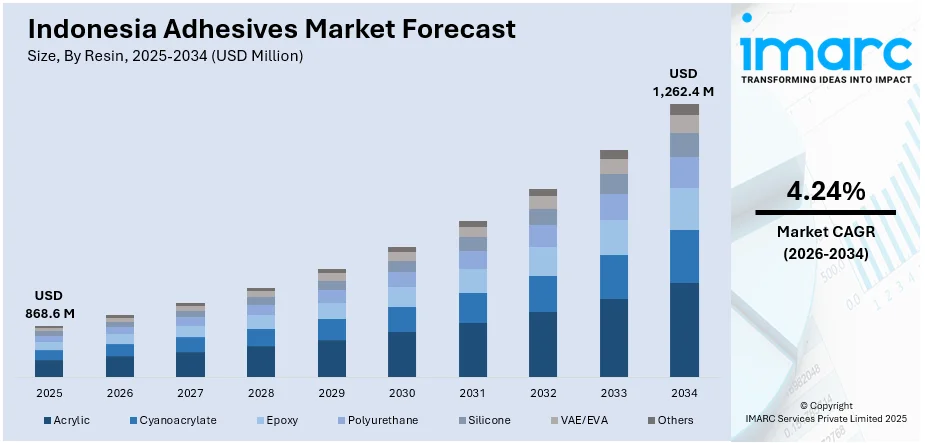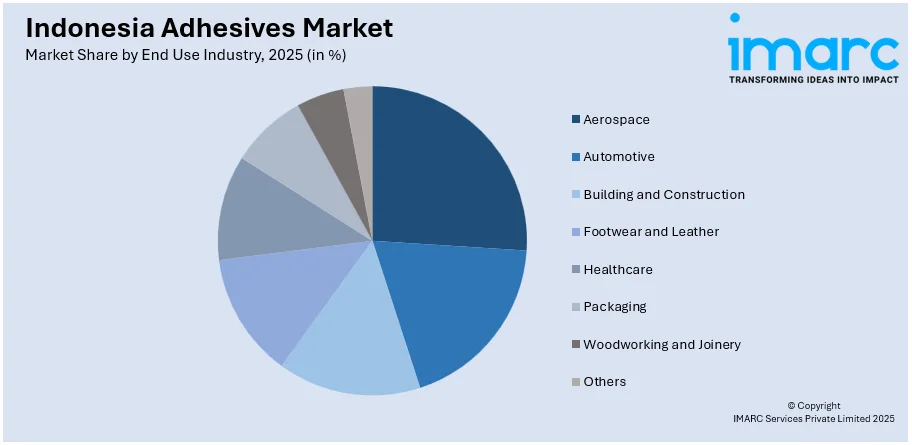
Indonesia Adhesives Market Size, Share, Trends and Forecast by Resin, Technology, End Use Industry, and Region, 2026-2034
Market Overview:
The Indonesia adhesives market size reached USD 868.6 Million in 2025. Looking forward, IMARC Group expects the market to reach USD 1,262.4 Million by 2034, exhibiting a growth rate (CAGR) of 4.24% during 2026-2034. The thriving construction sector in the country, increasing consumer awareness about sustainability, development of high-performance adhesives, growing consumer goods sector, implementation of government policies and initiatives, and the rising adoption of automated manufacturing processes represent some of the key factors driving the market.
|
Report Attribute
|
Key Statistics
|
|---|---|
|
Base Year
|
2025 |
|
Forecast Years
|
2026-2034
|
|
Historical Years
|
2020-2025
|
| Market Size in 2025 | USD 868.6 Million |
| Market Forecast in 2034 | USD 1,262.4 Million |
| Market Growth Rate (2026-2034) | 4.24% |
Adhesives refer to substances employed to bind two different surfaces together. They create a bond that resists separation and effectively attaches materials. Adhesives are manufactured from various base materials, including polyurethane, epoxy, silicone, and cyanoacrylate. They are available in multiple types, such as water-based, hot-melt, pressure-sensitive, and reactive adhesives, each with distinct properties like high tensile strength, shear resistance, thermal stability, and chemical resistance. Adhesives are widely utilized in various sectors, including automotive, construction, packaging, furniture, healthcare, electronics, and textiles. They offer numerous benefits, such as strong bonds, material flexibility, weight reduction, and cost-effectiveness. Moreover, adhesives are easy to apply, have quick drying times, offer anti-corrosive properties, provide thermal and electrical insulation, and are eco-friendly in nature. In addition, they provide multiple advantages, such as better stress distribution, elimination of mechanical fastening systems, improved appearance of finished goods, increased design flexibility, and simplified inventory management.

To get more information on this market Request Sample
Indonesia Adhesives Market Trends:
The thriving construction sector in Indonesia, prompting the demand for adhesives in materials like concrete, tiles, and wood, is creating a positive outlook for the market. Additionally, the country's burgeoning automotive industry, requiring adhesives for assembly and repair, is contributing positively to the market growth. Moreover, the widespread product application in sectors like electronics, textiles, and furniture for binding fabrics and securing electronic components is favoring the market growth. In addition to this, the growing awareness among consumers about sustainability and eco-friendliness, leading to the rising demand for bio-based and water-based adhesives, is providing a thrust to the market growth. Furthermore, the development of high-performance adhesives that can withstand extreme temperatures and corrosive environments is acting as growth-inducing factors. Along with this, the growing consumer goods sector in the country, prompting the need for lightweight and strong bonding solutions in packaging materials, is boosting the market growth. Furthermore, the increasing utilization of surgical adhesives in the healthcare sector for wound care and other medical applications is positively impacting the market growth. Besides this, the implementation of government policies and initiatives that encourage the development of local manufacturing, generating more opportunities for adhesive products in domestic and industrial applications is supporting the market growth. In confluence with this, the introduction of trade policies that favor the export of locally manufactured goods, incentivizing businesses to adopt high-quality adhesives to meet international standards, is providing an impetus to the market growth. Additionally, the rising adoption of automated manufacturing processes, facilitating the demand for adhesives that are compatible with these mechanical systems in terms of application speed and bonding strength, is anticipated to drive the market growth.
Indonesia Adhesives Market Segmentation:
IMARC Group provides an analysis of the key trends in each segment of the market, along with forecasts at the country level for 2026-2034. Our report has categorized the market based on resin, technology, and end use industry.
Resin Insights:
- Acrylic
- Cyanoacrylate
- Epoxy
- Polyurethane
- Silicone
- VAE/EVA
- Others
The report has provided a detailed breakup and analysis of the market based on the resin. This includes acrylic, cyanoacrylate, epoxy, polyurethane, silicone, VAE/EVA, and others.
Technology Insights:
- Hot Melt
- Reactive
- Solvent-borne
- UV Cured Adhesives
- Water-borne
A detailed breakup and analysis of the market based on the technology have also been provided in the report. This includes hot melt, reactive, solvent-borne, UV cured adhesives, and water-borne.
End Use Industry Insights:

Access the comprehensive market breakdown Request Sample
- Aerospace
- Automotive
- Building and Construction
- Footwear and Leather
- Healthcare
- Packaging
- Woodworking and Joinery
- Others
The report has provided a detailed breakup and analysis of the market based on the end use industry. This includes aerospace, automotive, building and construction, footwear and leather, healthcare, packaging, woodworking and joinery, and others.
Regional Insights:
- Java
- Sumatra
- Kalimantan
- Sulawesi
- Others
The report has also provided a comprehensive analysis of all the major regional markets, which include Java, Sumatra, Kalimantan, Sulawesi, and Others.
Competitive Landscape:
The market research report has also provided a comprehensive analysis of the competitive landscape in the market. Competitive analysis such as market structure, key player positioning, top winning strategies, competitive dashboard, and company evaluation quadrant has been covered in the report. Also, detailed profiles of all major companies have been provided.
Indonesia Adhesives Market Report Coverage:
| Report Features | Details |
|---|---|
| Base Year of the Analysis | 2025 |
| Historical Period | 2020-2025 |
| Forecast Period | 2026-2034 |
| Units | Million USD |
| Scope of the Report | Exploration of Historical Trends and Market Outlook, Industry Catalysts and Challenges, Segment-Wise Historical and Future Market Assessment:
|
| Resins Covered | Acrylic, Cyanoacrylate, Epoxy, Polyurethane, Silicone, VAE/EVA, Others |
| Technologies Covered | Hot Melt, Reactive, Solvent-borne, UV Cured Adhesives, Water-borne |
| End Use Industries Covered | Aerospace, Automotive, Building and Construction, Footwear and Leather, Healthcare, Packaging, Woodworking and Joinery, Others |
| Regions Covered | Java, Sumatra, Kalimantan, Sulawesi, Others |
| Customization Scope | 10% Free Customization |
| Post-Sale Analyst Support | 10-12 Weeks |
| Delivery Format | PDF and Excel through Email (We can also provide the editable version of the report in PPT/Word format on special request) |
Key Questions Answered in This Report:
- How has the Indonesia adhesives market performed so far and how will it perform in the coming years?
- What has been the impact of COVID-19 on the Indonesia adhesives market?
- What is the breakup of the Indonesia adhesives market on the basis of resin?
- What is the breakup of the Indonesia adhesives market on the basis of technology?
- What is the breakup of the Indonesia adhesives market on the basis of end use industry?
- What are the various stages in the value chain of the Indonesia adhesives market?
- What are the key driving factors and challenges in the Indonesia adhesives?
- What is the structure of the Indonesia adhesives market and who are the key players?
- What is the degree of competition in the Indonesia adhesives market?
Key Benefits for Stakeholders:
- IMARC’s industry report offers a comprehensive quantitative analysis of various market segments, historical and current market trends, market forecasts, and dynamics of the Indonesia adhesives market from 2020-2034.
- The research report provides the latest information on the market drivers, challenges, and opportunities in the Indonesia adhesives market.
- Porter's five forces analysis assist stakeholders in assessing the impact of new entrants, competitive rivalry, supplier power, buyer power, and the threat of substitution. It helps stakeholders to analyze the level of competition within the Indonesia adhesives industry and its attractiveness.
- Competitive landscape allows stakeholders to understand their competitive environment and provides an insight into the current positions of key players in the market.
Need more help?
- Speak to our experienced analysts for insights on the current market scenarios.
- Include additional segments and countries to customize the report as per your requirement.
- Gain an unparalleled competitive advantage in your domain by understanding how to utilize the report and positively impacting your operations and revenue.
- For further assistance, please connect with our analysts.
 Request Customization
Request Customization
 Speak to an Analyst
Speak to an Analyst
 Request Brochure
Request Brochure
 Inquire Before Buying
Inquire Before Buying




.webp)




.webp)












